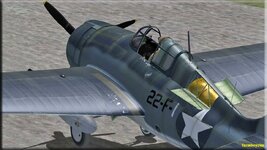I guess you skipped over my point #5:American pilots were complaining about the performance against the Zero, the Hurrican did no better and was less powerfully armed. The performance of the Wildcat and Sea Hurricane were about the same with either having advantages in certain areas. Both were inferior to Axis aircraft in 1942
"5) I'm pretty certain that your average F4F-4 Wildcat pilot who was complaining about his aircraft's poor climb rate and manoeuvrability (and whose reports were passed up the line to Nimitz) would be quite happy to fly an aircraft that weighed ~10% less with the same wing area and had ~20% more power... This is hard truth here and we have to recognize it. Yes, the F4F-4 has some superior attributes like folding wings but why then did the FM2 design team spend countless hours and dollars to come up with a lightweight carrier fighter in 1944 that only just matched the mid 1941 SH1B in range and performance?"
At typical 1942 combat altitudes (under 10-15K ft) the Sea Hurricane 1B could outturn, outclimb, outrun, out dive and out roll an F4F-4. Only above 15K ft did the F4F-4 have a slight edge in speed. In any event we've discussed this to death already. The HS1B has a 30% advantage in power to weight, with a similar frontal and wing area. You have to ignore the basic laws of physics and aerodynamics and actual test reports to claim that "..they have about the same performance..."
The FM2 (Martlet VI) has considerably superior performance to an F4F-4 for exactly the same reasons as the HS1B; it's lighter and has more power with the same frontal and wing area. This should be easy for anyone to understand.

